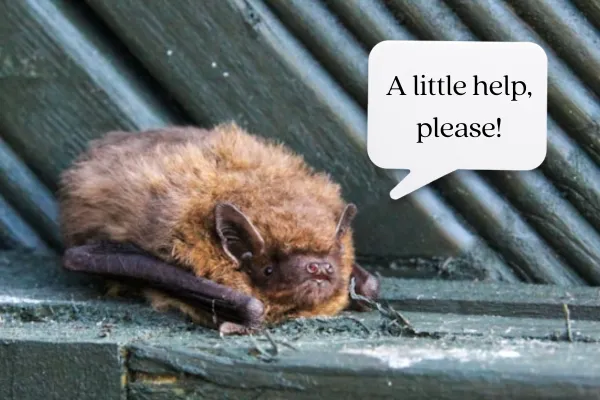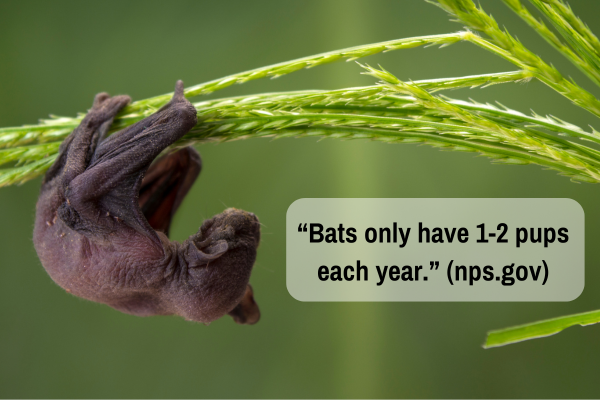Note: You may filter by category below. To use search feature for all categories return to main blog page here.

Bat Conservation: Why Bats Need Our Help More Than Ever
This post contains an affiliate link. As an Amazon Associate I earn from qualifying purchases.
This week on my business page I shared a concerning statistic about bats, and here is a follow up about how we can help. Bats are great for natural insect control and are a welcome sight to see. I love to watch their sporadic flight patterns over my yard as they dive for their dinner! Bats also serve an important role in the food chain and as pollinators. Let's take a look at why we should prioritize bat conservation.
What's Plaguing the Bat Population?
Of great concern, there is something wiping out these tiny flying mammals. White Nose Syndrome (WNS) is a highly contagious fungus among bat colonies that has devastated the bat population.
Just how deadly is it? Unfortunately WNS can affect an entire colony. According to whitenosesyndrome.org, "White-nose syndrome has killed millions of bats in North America. At some sites, 90 to 100 percent of bats have died. Several species are affected, with the hardest hit being the northern long-eared bat, little brown bat, and tricolored bat."
According to usgs.gov, "white-nose syndrome has killed over 90% of northern long-eared, little brown and tri-colored bat populations in fewer than 10 years." It's a heartbreaking number! This has led to several North American bat species being listed as federally endangered or threatened, and many at the state level. In fact, "more than one-half are of current conservation concern in the United States, Canada, or Mexico" per usgs.gov.
Bat Houses as a Conservation Effort

Focusing on the positive steps we can take as individuals, installing bat houses can help their populations recover by providing roosting sites that are free from WNS. You can build your own, or purchase one like this, which comes in multiple colors depending on your local climate.
For tips on bat house installation and how to attract bats to your yard check out Bat Conservation International's guidelines. Batweek.org also offers a great resource for the DIYer, The Bathouse Builders Handbook that you can view here. Page six through nine cover key factors for success with bat houses.
In general, place bat houses high up on a pole or building structure. They are known to find these much faster than houses mounted to trees. Bats are most likely to roost where they feel safest from predators, where bat house height comes into play. Sun exposure is another important factor, as too little sun can lead to an unoccupied home.
Offering chambers at different temperatures can help bats survive throughout the year during extreme weather conditions. This could be done by installing dark and light-colored houses, or even back-to-back house arrangements. A dark-colored house may help bats winter over in colder climates, while light colored houses help them regulate on peak summer days. Providing a variety of options helps bats conserve their energy most efficiently.
Other Ways to Support Bats

To help support bats and other local wildlife you can also plant more native species in your yard and avoid using pesticides. For specific plants visit Garden for Wildlife's article "Bats & Blooms: Creating a Bat-Friendly Native Plant Garden" linked here. Night blooming plants like evening primrose can attract insect for bats to forage on. Or in the Southwest region, plants like agave can feed nectar-feeding bats.
Don't forget to add a water source for bats and other life visiting your yard. Access to water is critical for the survival of so much of life on Earth, including bat species.
Consider leaving standing dead trees, also called snags, if they do not pose a danger. These offer habitat to many species and can serve as a roosting spot for bats. To read more about snags and how they support the ecosystem you can read my brief blog post.
Limit tree pruning activities to the spring and fall to prevent injuring bat pups. Fun fact, did you know that bats only have 1-2 pups a year? (source: nps.gov)
Do a quick web search to find out which bats species are listed as Endangered or of Special Concern in your state. When we take a moment to slow down and assess the species right in our backyards that need the most help then we can seek out meaningful ways to help them survive ...and hopefully, to one day thrive again.
I want to leave you with a hopeful statistic from Bat Conservation International, that an "increase in species recovery of 14% over the last 15 years provides evidence that collaborative conservation efforts can change the trajectory for bats." When more backyard conservationists support bat species I believe we can see this statistic improve. So which strategies will you implement to help these important little mammals recover?
To receive future blog posts click the button above to opt-in. I also invite you to follow me on my Facebook™ business page, and in the Sustainability & Wellness Seekers Facebook™ Group, linked here. You are welcome to join the community conversations!
Copyright 2023 Beth Manteuffel All rights reserved


